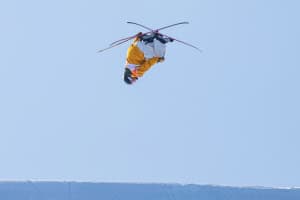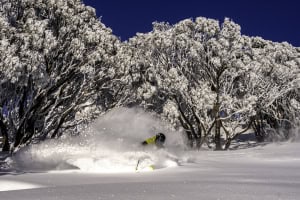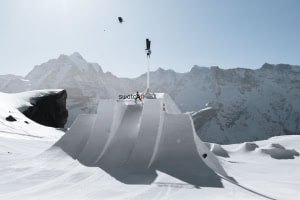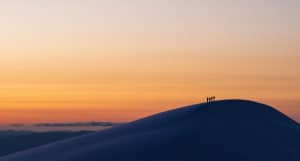Skiing in South Korea, Pass the Kimchi – Travel
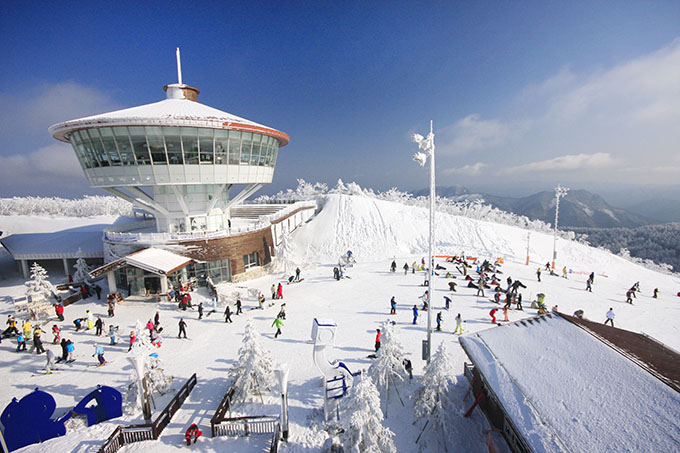
South Korea is a ski destination that’s attracting an increasing amount of international attention thanks to the upcoming Pyeongchang 2018 Winter Olympics. High1 Resort, pictured here, is Korea’s newest resort, having opened just six years ago in 2009 Image:: High1 Resort
For athletes and fans it feels like the hype of another Olympic year has barely passed, but there’s one nation already buzzing with anticipation and trepidation for the 2018 Winter Olympiad: South Korea. As a country not widely known as a ski destination, South Korea endured a long road involving two failed bid attempts plus the associated IOC skepticism before they were successful in winning the right to host the 2018 Olympics. In the end, it was their deep-rooted cultural values of persistence, optimism and patience that finally enabled them to win their Olympic bid in 2011. Now that the end goal is within sight, South Korea want to tell the world about it – in fact, they’re screaming it from the rooftops. Mountainwatch’s Alex Horvath recently had the opportunity to visit South Korea, here’s what he discovered…
Mountainwatch | Alex Horvath
As we arrived in Seoul’s Incheon Airport, and then made the one-hour drive to downtown Seoul, my eyes were transfixed on the view as the sprawling urban metropolis of 25.6 million people flew by. Over half of South Korea’s population lives there, and its sheer size was breathtaking. Downtown Seoul is only 50km from the 38th Parallel, making it practically a stone’s throw from the border with North Korea. As we negotiated peak hour traffic – far worse than Sydney – and made our way to the city’s centre, our local guide, Jinny Kim, explained that Seoul is a city with a chequered past. Over the years it has endured invasions from all of its nearest neighbours: China, Japan, Russia, plus the ever-present cold war between Korea’s two factions. But as I sensed from Kim’s enthusiastic manner, the South Korean people have emerged from the ordeal with a unique and empowered sense of individuality. With such stark contrasts existing between South and North Korea, I couldn’t help but consider the economic and social disparities that existed within such a short radius of where we were.
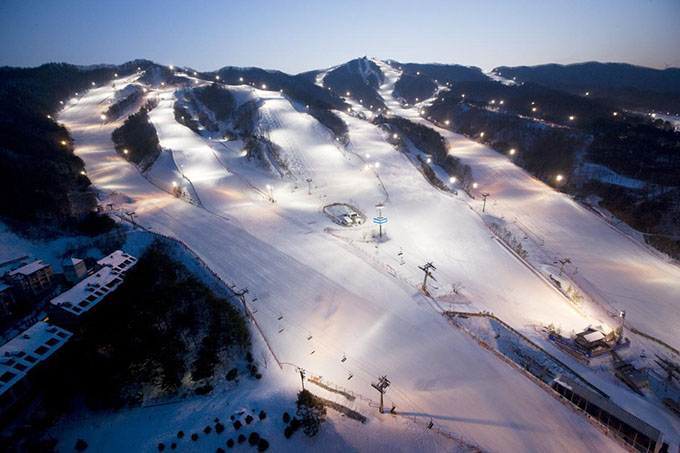
Phoenix Park is one of four resorts in the Pyeongchang Mountain Cluster and will host all of the freestyle Snowboard and Ski events in 2018 Image:: Phoenix Park
THE MIRACLE ON THE HAN RIVER
Skiing is relatively new to South Korea, and naturally, so are their ski resorts. The young nation enjoyed one of the fastest growing economies in the world from the ’60s, right through to the ’90s. The period became known globally as “The Miracle on the Han River” and it transformed South Korea from war-torn turmoil, into one of the world’s most influential economies. It was lessons learned during this period of rapid growth that prompted the government to envisage the benefits the lucrative ski-tourism dollar could provide. This set the wheels in motion, and in 1975, Korea’s first resort, Yongpyong, opened. Skiing became an attractive winter pursuit for locals, but it wasn’t until 1992 – when Short Track Speed Skater Kim Ki-Hoon brought home their first Winter Olympic Gold medal – that the sport really took off.
Kim’s medal made headlines around the nation, “When a Korean makes a big sporting achievement, the people go crazy,” Jinny told us. And crazy they went: “This Olympic achievement led to a huge uptake in winter sport. People all over the country started deciding that they wanted to go skiing on their weekends and holidays. Korean people are like that, they love and adore anything popular – just like K-pop Music.”
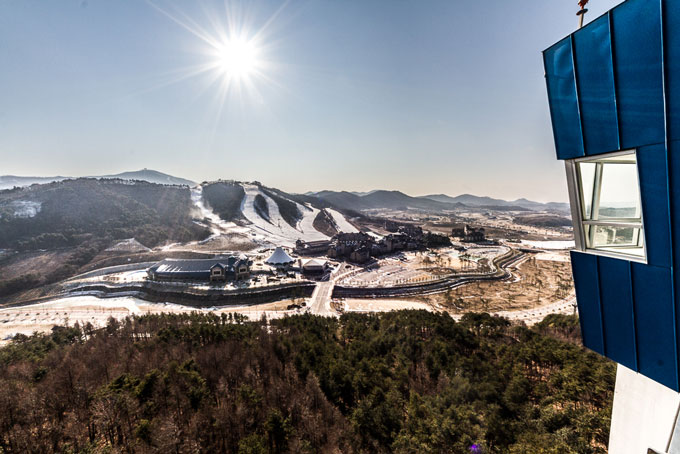
Here you can see Alpensia resort, which will host the main Olympic village, media centre, Olympic Stadium and the Sliding centre. The shot is taken from the Alpensia Ski Jump tower Image:: Alex Horvath
THE MOUNTAINS
Since those early beginnings, skiing has become entrenched in South Korean culture and has fast become a way-of-life. The nation now has around seventeen ski resorts – the largest are scattered throughout Gangwon-do province, which is the location where the Pyeongchang 2018 Olympics will be held – and a population of 6.3 million skiers and snowboarders. Gangwon province is situated in South Korea’s northeast corner, amongst the Taebaek Mountains that stretch 500 kilometres from North Korea, along the peninsula’s eastern fringe, down to the southern-most tip of South Korea’s coastline. The Taebaek Mountains average only 1000 metres in elevation – very low by international standards. Pyeongchang county is the region where the Olympics will be centred, and it is also home to the four major ski-resorts: Alpensia, Yongpyong, Phoenix Park and High1 Resort – these are also the areas most frequented by western tourists.
THE SNOW
The South Korean ski season runs from early December through March. Before arriving there, my conversations with friends centered on how much snow they usually received during an average winter. Based mainly on its geographic proximity to Japan, we were under the assumption that South Korea’s climate and snowfall totals would be somewhat similar to neighbouring Japan. How wrong we’d been.
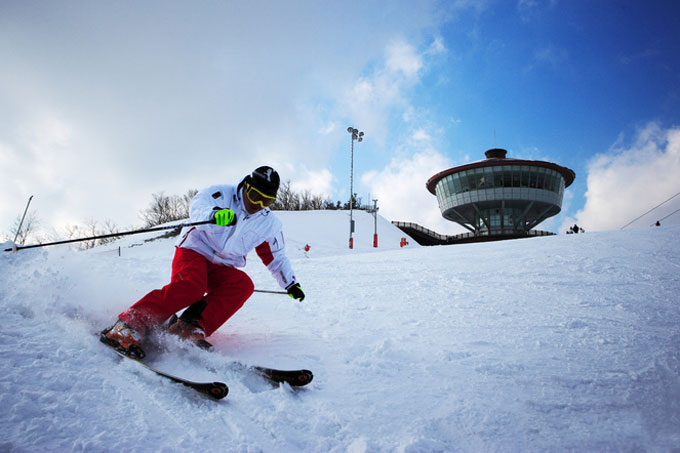
Skiing is already hugely popular in South Korea, but it’s expected that the Pyeongchang games will really help to boost the sport both at home and around the rest of Asia, too Image:: High1
The crucial difference between the Japanese powder-factory and the much drier Korean peninsula is the Sea of Japan (East Sea). The snow-bearing systems in this part of the world come from the northwest, as cold, dry air moves in from Siberia. In Japan, the Sea of Japan (East Sea) loads this airmass with moisture as it travels toward the Japanese islands. But in Korea, this air travels directly across the great plains of China and Mongolia, and then it hits the low-lying Taebaek Mountains in South Korea. The result of all this: South Korea employs the most extensive, and most efficient artificial snowmaking system I have ever witnessed.
Our visit fell at the beginning of December, early season by all accounts. Each resort had only artificial snow on offer – I noticed huge piles of man-made snow on the closed pistes; it seemed as if the entire resort could be opened after just a few more days of snowmaking. While visiting Phoenix Park – the resort that will play host to the freestyle ski and snowboard events of Pyeongchang 2018 – I posed the question to our local resort host: “How many days on average do you experience natural snow?” She looked puzzled by my enquiry. She asked: “Do you mean powder snow? Oh no, not in Korea. Our snowmaking system is capable of producing 20,000m3 of man-made snow per day. So we never worry about whether there is enough natural snow.” At the time, I couldn’t help but notice that her comment was made off-the-cuff, dismissing my concerns about natural snowfall with a quick and curt reply. I let it go, considering the ramifications when trying to attract western tourists who currently flock to the islands of Japan on the promise of the deepest and driest powder snow known to man. Don’t get me wrong, there was no shortage of snow on the open runs, but the damp crunch and grainy feeling of the man-made snow underfoot was unmistakable – it just doesn’t compare to the real thing.
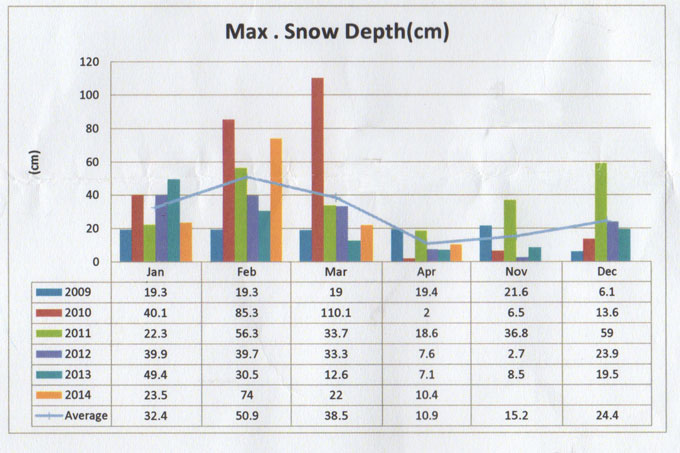
As you can see in this graph, natural snow is a rare commodity in South Korea Image:: POCOG
THE TERRAIN
Like other ski destinations in Asia, the mountains in South Korea lack elevation. The slopes of Alpensia, Phoenix Park, Yongpyong and High1 are all situated just 700 – 1500 metres above sea level. The terrain rises gently, comprised of predominantly volcanic rangeland that looks similar to the low-lying slopes of Japan’s north island. None of the terrain within any of the ski areas is above the tree line, and every resort employs high chain-link fences to line each and every ski slope. Tree skiing is absolutely not an option.
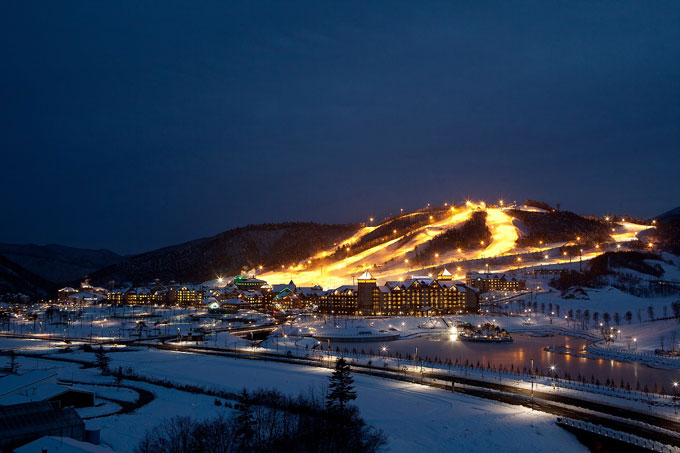
The 5-Star Intercontinental in Alpensia will the hotel of choice for the more wealthy guests during the games Image:: Alpensia
The infancy of skiing in South Korea has meant that each resort is well designed for the needs of predominantly beginner and intermediate skiers. The ski resorts are also well suited for racing and competition, with purpose-built alpine and freestyle facilities dotted amongst the areas with the best spectator potential. I felt that the designs and layouts had an almost made-to-order feel about them; each one perfectly designed for its role in the upcoming Olympics. According to the Pyeongchang Organising Committee (POCOG), it was the close proximity and purpose-built feel of the ski areas that helped them to win the 2018 Olympic bid. The Pyeongchang Mountain Cluster will be host to the most compact Winter Olympic Games ever held – each centre will be within a 30-minute drive of the Olympic Village.
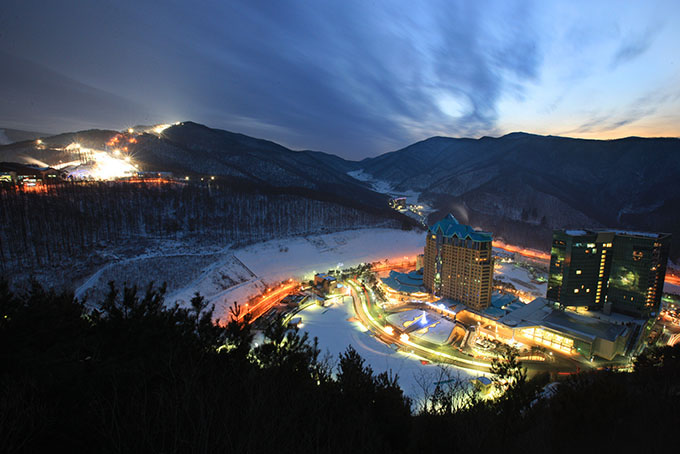
High1 ski resort features the only casino in South Korea that allows South Korean nationals to gamble within its walls. It’s also a wholly government-owned resort complex Image:: High1
OFF-SNOW
Beyond the skiing, it’s obvious that plenty of foresight was given to activities for non-skiers. Big shopping centres lie at the bottom of the slopes, with both indoor and outdoor water parks never more than a short walk away from the main lift. Accommodation varies from youth-focussed hostels, to five star, luxury hotels and condominiums – the scales are tipped firmly in favour of the latter.
Curiously, High1 resort is also the host of the one and only casino that allows South Koreans to gamble. There is a swathe of Casinos across the country, but this one – located in the wholly government-owned High1 resort – is the only one that allows South Korean nationals to gamble. The rest are reserved for foreigners. This seemed like an odd addition to the ski resort. The casino is obviously a big earner, with plenty of Vegas-like neon lights garnishing the plaza in front of the hotel. With the incredibly packed casino and the relatively empty ski slopes, it almost felt like skiing was an afterthought.

In Jeongseon County nearby to Phoenix Park, the local specialty is a dried fish called Pollock fish. After a big day’s skiing, the locals all come down and crowd these restaurants late into the night. Local restauranteur, Sun Yeol Kim has owned this restaurant for 20 years. She told us that she is excited for the increase in tourism that the Olympics will surely bring. Here, she poses with the Hwang Tae that’s dried on racks known as, Deokjang Image:: Alex Horvath
FOOD & CULTURE
While the snow conditions and terrain in South Korea may be lackluster for more experienced and well-traveled western skiers, sometimes it’s the other elements of a trip that leave a lasting impression. The cultural experience was really the highlight of my time spent in South Korea. I may not have memories of deep powder and steep terrain, but the experience, understanding and knowledge of South Korea’s rich cultural heritage will stay with me for a long time.
Firstly, the food: South Korea’s cuisine is fresh, spicy, vibrant and varied. It’s unlike either of its neighbours, completely different to Chinese or Japanese cuisine – probably reflective of the South Korean people’s determination to avoid the cultural influence of either. Ever-present, Kimchi accompanies every meal. The term refers primarily to the fermented cabbage that is slathered in chilli and other spices, then left to ferment in clay jars for up to one year. The cabbage is the staple variety but other fermented vegetables like sweet potato and cucumber will always accompany it. The longer it’s fermented, the more prized the Kimchi – did I tell you they eat it with everything?

In downtown Seoul, the Gwangjang Market is well worth the visit. Downstairs, you can find a selection of unique South Korean seafood, such as the chilli crab pictured here, and then on the first floor you find a huge selection of Korean Silk and Satin merchants Image:: Alex Horvath
Each and every county within Gangwon province has its regional specialty. In Yongpyong, we sampled Hanwoo beef. Hanwoo is high-priced beef sourced from local farms. It’s known for its beautifully marbled texture and consumed at specialised Korean BBQ restaurants. Then in Jeongseon County nearby to Phoenix Park, we ate Pollock fish, a species of cod that’s caught in the Pacific Ocean’s northern latitudes and laid out on open-air wooden racks to allow the fish to repeatedly freeze and thaw, giving it a particularly chewy half-dried texture. Spicy; exotic; full of garlic; Korean cuisine is not for the fussy palate, but it’s certainly an experience that leaves an indelible impression.
Of course, none of this would have been as memorable were it not for the incredible hospitality offered to us by the South Korean people. Every local we came across was eager to please, bombarding us with requests for advice, boundless enthusiasm and a determination to improve the tourist experience in the face of the international attention.
ROUNDING IT OUT
It’s safe to say that South Korea offers a unique ski holiday experience that is most certainly unlike any other destination in the world. What it lacks in fresh snow, it more than makes up for in a rich and vibrant cultural experience. The nation and the culture will be on show in 2018, and I have no doubt that they will pass the test with flying colours by putting on a unique and exciting Olympics. Beyond the games, South Korea hopes to be able to secure their place as the new hub of winter sport in Asia, in the process, providing a new way for Gangwon Province to be more economically sustainable well into the future. Interestingly, before Pyeongchang 2018, the only other country in Asia to have hosted both winter and summer games is Japan. Time will tell if it works out.

Alpensia’s Ski Jump tower. This Ski Jump tower and Nordic sliding centre hope to become the premiere hub for Ski Jumping and Nordic competition after the 2018 Olympics. With their incredibly efficient snow making systems they have ensured they will have skiable facilities whenever nature can’t provide natural snow Image:: Alex Horvath
GETTING THERE:
Korean Air flies direct, SYD – ICN daily. Flights leave at 8:55am and arrive in Seoul at 17:50 local time. Seoul to Pyeongchang is a three-hour drive and shuttle buses run daily. A high-speed rail link between Incheon Airport and the Olympic village will be completed by 2017; it hopes to cut the travel time to just one-and-a-half hours.


